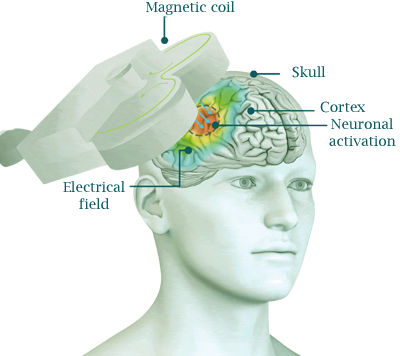

Many people with mental health conditions, such as depression, anxiety, obsessive-compulsive disorder (OCD), or post-traumatic stress disorder (PTSD) don't respond well to medications. In fact, many people don't want to take psychiatric medications at all because of their long-term side effects.
Unlike psychiatric medications, TMS therapy is a more holistic and effective approach to treating such illnesses, and offers long-term relief from the debilitating symptoms of depression, anxiety, and other mental health conditions. TMS is covered by insurance for specific FDA-approved conditions.
Transcranial magnetic stimulation (TMS) is a non-invasive procedure that uses magnetic fields to stimulate nerve cells in the brain to improve symptoms of depression. This treatment for depression involves delivering repetitive magnetic pulses, so it's called repetitive TMS or rTMS. First developed in 1985, rTMS has been studied as a treatment for depression, psychosis, anxiety, and other disorders.
During TMS session, an electromagnetic coil is held against the forehead near an area of the brain that is thought to be involved in mood regulation. Then, short electromagnetic pulses are administered through the coil. The magnetic pulses easily pass through the skull, and causes small electrical currents that stimulate nerve cells in the targeted brain region. It's thought to activate regions of the brain that have decreased activity in depression.
Because this type of pulse generally does not reach further than two inches into the brain, scientists can select which parts of the brain will be affected and which will not be. The magnetic field generated by TMS is comparable to that of a standard magnetic resonance imaging (MRI) device.
As these magnetic fields move into the brain, they produce very small electrical currents. These electrical currents activate cells within the brain which are thought to release neurotransmitters like serotonin, norepinephrine, and dopamine. Since depression is thought to be the result of an imbalance of these chemicals in the brain, TMS can restore that balance and, thus, relieve depression.
TMS is well-tolerated and associated with few side-effects. Side effects are generally mild to moderate and improve shortly after an individual session and decrease over time with additional sessions. The most common side effect, which is reported with TMS, is headaches. Tingling, spasms or twitching of facial muscle or brief lightheadedness may result. Sometimes a person may have discomfort at the site on the head where the magnet is placed. The most serious risk of TMS is seizures. However, the risk of a seizure is exceedingly low. While TMS is a safe procedure, it is important to point out that because it is a new treatment, there may be unforeseeable risks that are not currently recognized and long-term side effects are unknown.
TMS has NOT been associated with many of the side-effects caused by antidepressant medications, such as gastrointestinal upset, weight gain, dry mouth, or sedation.

